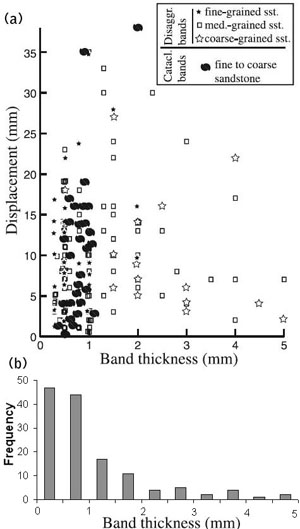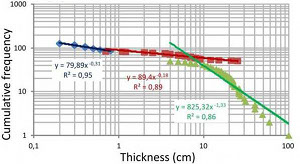| |||||||
|
|
|||||||
|
|
|||||||
| Shear Band Thickness | |||||||
|
Earlier studies focusing on single shear bands reported a narrow range of thicknesses; 0.15 to 1.5 mm (Engelder 1974) and 0.7 to 1.2 mm (Aydin, 1978). More recent surveys revealed single shear bands as thick as 5 mm (Figures 1(a) and (b); from Fossen et al., 2007) and suggested variable shear band thickness with grain size; generally, thicker bands occurring in medium- to coarse-grained sandstones. Apparently, shear band thicknesses cannot be correlated with the shear displacements (Figure 1(a)), which will be revisited in the scaling section. Figure 2 shows frequency-thickness data collected from shear bands in the carbonate grainstone cropping out in the island of Favignana, west of Sicily (Tondi et al., 2012). The data shows that the thickness distribution for shear bands (both single and zone, blue and red, respectively) in the carbonate grainstone is limited in magnitude and is linear and flat in form but the well-developed shear bands with slip surfaces (green in the figure) have a strikingly different trend with a high inclination. | |||||||
| Reference: |
|||||||
| Aydin, A., Johnson, A.M., 1978 Engelder, T., 1974 Fossen, H., Schultz, R.A., Shipton, Z.K., Mair, K., 2007 Tondi, E., Cilona, A., Agosta, F., Aydin, A., Rustichelli, A., Renda, P., Giunta, G., 2012 |
|||||||
|
Readme | About Us | Acknowledgement | How to Cite | Terms of Use | Ⓒ Rock Fracture Knowledgebase |
|||||||

